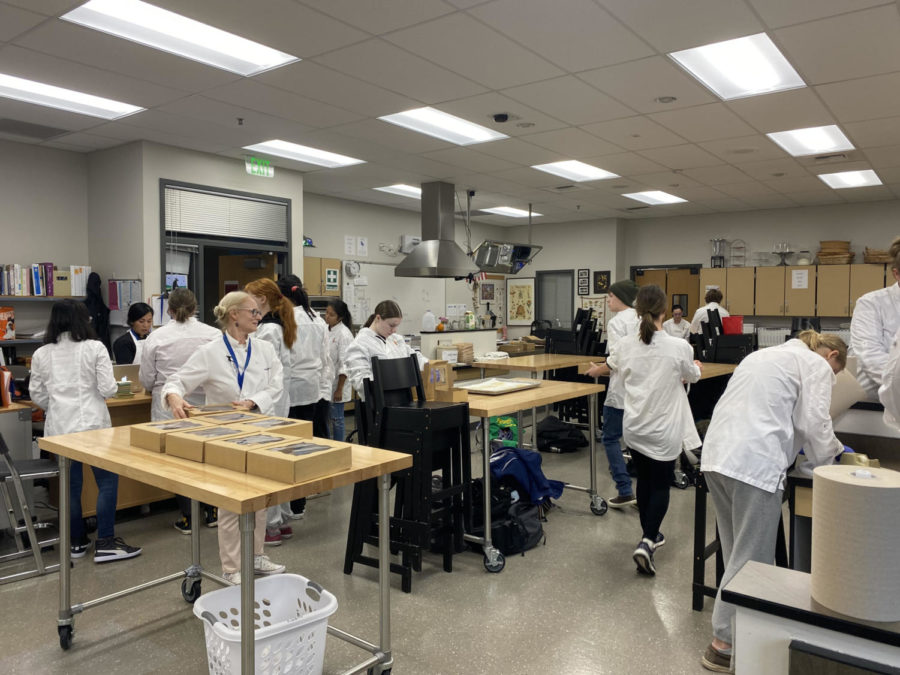A candle-lit tradition
The Culinary Arts chef dinner makes a comeback
by Audrey Gray
Chef Wendy Jordan and Culinary Arts students hard at work.
November 17, 2022
Participating in the creation and direction of a professional-quality chef dinner isn’t an experience many students get to have.
However, Shorewood has a long-standing tradition of organizing an event that is precisely that for Culinary Arts students to test their learning—a tradition that will return to the school in December for the first time since the pandemic started.
In 2020, the chef dinner was planned for the exact day the school went into quarantine and was canceled hours before the event.
It’s an important affair for Culinary Arts students; guests buy a ticket, and students help a professional guest chef with experience in the industry prepare a high-quality meal, presented in the Culinary Arts classroom that transforms into a candlelit restaurant. Students were preparing for weeks before the last planned dinner almost three years ago but never got to put their preparation to the test.
Chef Wendy Jordan, Culinary Arts instructor, believes this damaged the learning of that year’s class.
“The feeling of teamwork, and being able to apply what you’ve learned in a real world situation, left a huge gap [in the students’ learning],” she said. “If you’re taking a class and you’re learning information and you’ve got no way to really apply it, that’s not very motivating.”
This year, the guest chef is Shubert Ho, a local restaurateur with years of experience in the culinary industry. The guest chef is responsible for guiding the students, planning the meal, and discussing how to prepare it throughout the week before the event.
SeHee Kim is a sophomore in Culinary Arts, and it’s both her first year in the class and her first year participating in the chef dinner.
“I’m kind of nervous [to be working with a professional], but I’m hoping we can impress him with the skills we have now,” she said. “It’s kind of exciting because he runs restaurants.”
During the dinner, in which all Culinary Arts students regardless of age or experience participate, students can decide whether they want to work in the kitchen or in the house.
Throughout the year, they practice a variety of different skills. “We start out with food safety, and then start going through how to make foundational dishes, and then we move into the various cooking methods. Usually by then, that’s a pretty good foundation,” Jordan said. “[We also work on] soft skills. We talk a lot about teamwork, professionalism, things that are a little bit more difficult to teach.”
It’s a nerve-wracking experience for many students. Apart from the pressure that comes from working with a professional and serving paying customers, the chef dinner serves to judge students’ learning so far in the class. “It’s a requirement [and] a part of our event series,” Jordan stated, referring to a list of events that the culinary students participate in to test their abilities. “It’s a summative event—their version of a test, [applying] all their knowledge [to a practical situation].”
Since this is the first dinner in almost three years, no one really knows what to expect, which heightens the sense of anxiety in the class. “There’s a lot of fear, because there aren’t any students around who can attest to the fact that it’s doable,” Jordan said.
But as stressful as the event may be, it’s equally as exciting and valuable for the students.
“It’s kind of like a restaurant with customers. There’s a lot of teamwork involved, which we don’t have a lot of right now,” Kim said. “I’m excited about getting to know more people in my class. I’m also kind of interested in the customer service.”
In addition to the sense of teamwork it develops in the class, it can be immensely useful for students to get an idea of the culinary industry.
“It gives [students] a little taste of [the industry], like ‘do you really like this?’” Jordan said. “It also gives them access to an industry partner that maybe they normally wouldn’t have access to.
Many of the chefs who have done chef dinners with us in the past are more open to jobs for our students if they contact them.” Kim can attest to how the dinner might help with considering career prospects.
“I’m hoping to get more experience working with other people, and maybe seeing if I can take this as a career path,” she said. “I think I’ll be able to experience what happens in a real restaurant.”
Regardless of the mixed feelings of excitement and anxiety, though, the Culinary Arts chef dinner has made a prominent name for itself, especially among staff who remember the dinners. Says Jordan: “The chef dinners have a reputation that really lives on.”



